Attracting top talent isn’t always easy, especially in an increasingly competitive market. But what if you could flip the script? With Inbound Recruiting, candidates come to you!
By implementing a smart strategy, you can draw in qualified leads, boost your employer’s brand, and build a long-term talent pipeline. 😎
Check out the 4 key steps to attracting candidates rather than chasing them. ✨
The definition of inbound recruiting
Inbound recruiting is a recruitment method inspired by inbound marketing techniques. The idea is simple: instead of actively hunting for candidates, you take steps to naturally draw them in. 🧲
This concept revolves around building an appealing ecosystem around your company, where candidates are drawn to you on their own, captivated by your values and culture. ❤️🔥
The goal of this approach is to attract candidates organically, leveraging a strong employer brand and a carefully crafted content strategy. This way, you can create a pipeline and attract the right profiles without having to chase them down. 🏃🏻♀️➡️
4 benefits of inbound recruiting
Inbound recruiting offers several advantages that make it an especially effective strategy for attracting top-quality professionals. Here are the key benefits:
First off, attracting qualified candidates becomes much easier. By sharing relevant content—like blog posts showcasing your company’s projects or videos highlighting your culture—you naturally draw in people who align with your values and goals. For instance, picture an article titled “How to Innovate in Everyday Tech” that grabs the attention of developers passionate about innovation. This kind of content works like a magnet for candidates! 🧲
Secondly, you strengthen your employer brand. A well-crafted inbound recruiting strategy creates a positive, attractive image of your company. By sharing behind-the-scenes stories of your daily work, team successes, or employee testimonials, you showcase what it’s like to work for you. This not only draws in talent but also attracts people who align with your vision. 😎
Another major advantage: reduced recruitment costs. 💸 No more spending huge amounts on paid ads or headhunters. By implementing a content strategy that works for you over time, candidates come to you naturally, without the need for as much investment in ad campaigns.
Finally, inbound recruiting allows you to create a candidate pool. Even if a candidate doesn’t apply right away, they can stay in your database and be nurtured through engagement campaigns (via email, social media). This way, you always have a group of interested candidates you can reach out to when new opportunities come up. 👥
The disadvantages of inbound recruiting
Like any strategy, inbound recruiting also has its drawbacks:
- An investment in time and resources.Creating quality content, maintaining an active presence on social media, managing a website, preparing newsletters—all of this takes effort. 💼 It often involves multiple teams: marketing, HR, communications. And if you don’t have the resources in-house, you may need to hire external experts (community managers, copywriters, etc.), which can drive up initial costs. 💸
- A process that requires patience.This isn’t a quick fix where you see results overnight. Unlike outbound recruiting, where you send job offers directly to the right candidates and get fast responses, this approach takes time to gain traction. 🌱 Candidates need to discover your company, engage with your content, and it can take weeks or even months before they decide to apply. But the good news is, the results are often more sustainable and of higher quality! ✨
The 4 stages of the inbound recruiting process
Inbound recruiting is a structured process. The goal? Attract potential candidates, convert them into leads, recruit them, and then retain them so they become your best ambassadors. Here are the 4 steps to making it happen! 🤩
Step 1: Attract
The goal of this first phase is to grab the attention of potential candidates by offering attractive and valuable resources. At this stage, they may not even know you exist, but with a strong content strategy and the visibility you build, you’ll be able to capture their interest and drive them to your pages, job listings, or career site. 🤩
➡️ Here’s how:
- Website: Your website should contain information for candidates. It should include a career page or a link to a Joboard (Indeed, welcome to the jungle) your job offers and why it’s great to work for you.
- Company pages: Be active on your LinkedIn, Facebook or Instagram pages. Candidates want to see the company atmosphere, what’s going on and why they should be interested. Show employees’ daily lives, internal events… 🎉
- Blog: Write articles on topics related to your industry. You can write about your company culture, innovations in your field or topics that might interest your persona. This SEO-optimized content will help you attract organic traffic and therefore more visitors.💎
- Social networks: Using these channels, you can publish relevant posts, including testimonials, videos and articles. A good social media strategy helps maintain your company’s visibility and attract the attention of new talent who discover your offerings.
Example: a tech company highlights the testimonials of its developers on LinkedIn, explaining the innovative technologies they use. This attracts profiles passionate about innovation and leads them to visit the company’s career site. 🙌🏻
Step 2: Convert
Grabbing visitors’ attention is great, but now it’s time to turn them into engaged leads. The goal here is to collect their information so you can follow up and nurture them until they’re ready to become active candidates.✨
➡️ To do this, you can create :
- Contact forms: Offer registration forms on your site so that visitors can subscribe to a career newsletter, create a profile or sign up for a job alert. This information allows you to stay in touch with them over the long term.☎️
- Download exclusive content: Offer a white paper, ebook or other useful support in exchange for the visitor’s e-mail address. For example, an ebook on “Recruitment trends in 2024” can be very attractive to potential candidates who want to stay on the cutting edge of HR practices.📚
- Unsolicited applications: Give visitors the opportunity to send you their CV, even if they don’t find a job offer matching their profile. This allows you to build up a pool of potential employees you can contact later.📇
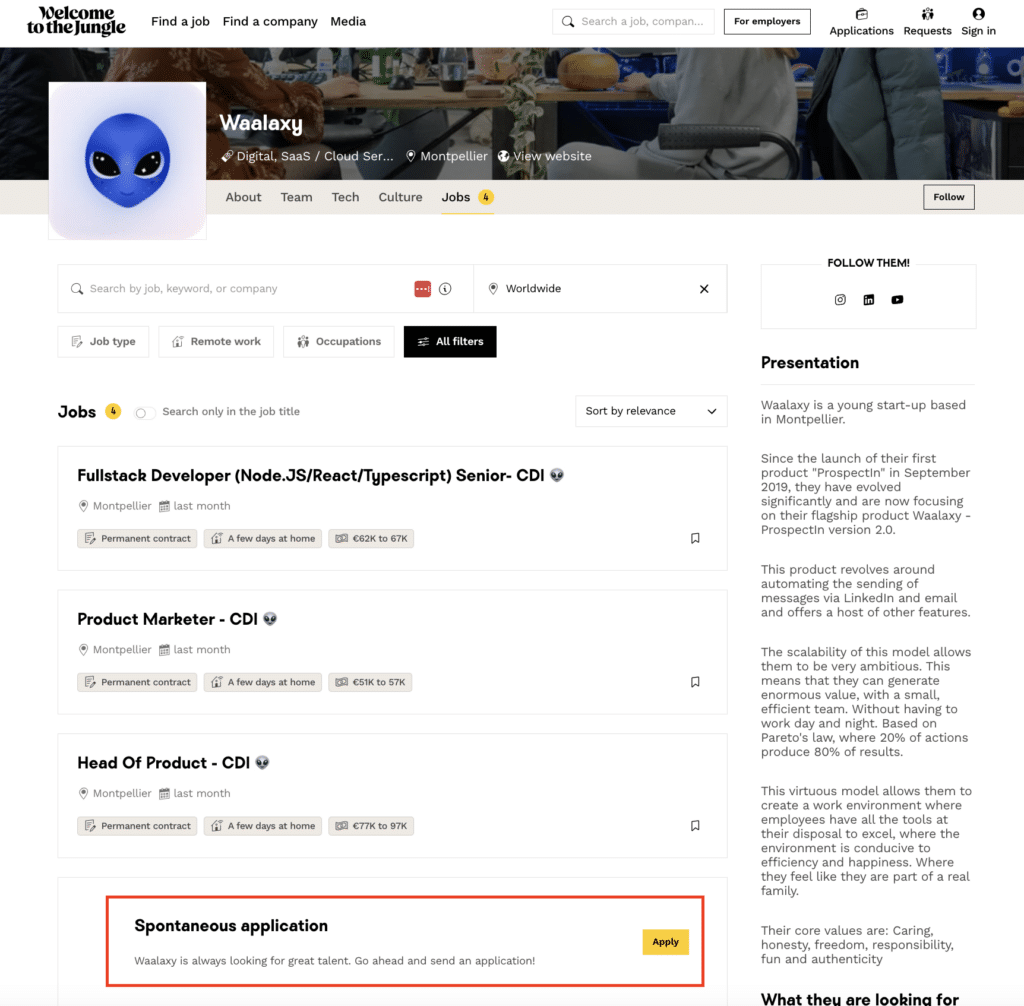
- Online events : Organize webinars or online events to present your company and its professions. At the end of these events, you can encourage participants to sign up for your HR newsletter or apply for a job. 💻
- Job advertisement is an other way to promote opportunity in your company, and you can learn how to write a job advertisement.
Step 3: Recruit
Once you’ve converted your visitors into leads, it’s time to turn them into active candidates. The recruitment phase needs to be structured to be fluid and responsive. For this, you can use tools like Waalaxy!👽
What is Waalaxy?
Waalaxy is a Google Chrome extension, available free of charge or by subscription. It enables you to automate your LinkedIn prospecting campaigns and e-mail in total security. Whether you’re a beginner or an advanced user, it’s a simple and effective tool suited for all kinds of professionals: recruiters, salespeople, marketers, agencies, executives, and more. 🌟
Here’s why Waalaxy is a must-have tool for recruiters:
- All-in-one solution: Whether you want to automate LinkedIn messages, retrieve emails, or more, Waalaxy covers it all—no training required. 👀
- No database needed: You can start without needing an email directory 📇
- Accessible to all: You don’t need to be a tech expert or have advanced skills. Even beginners can use the platform after just a few minutes. 😎
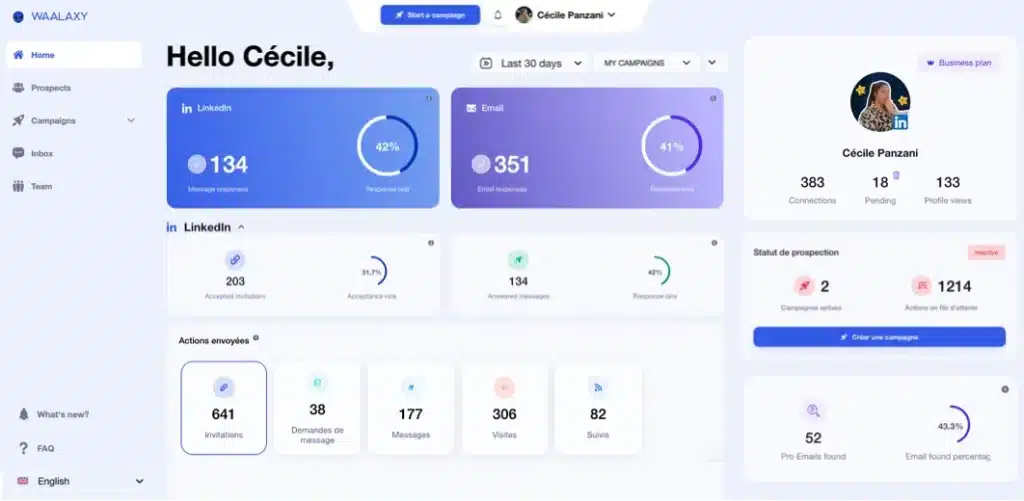
Why is it interesting for inbound recruiting?
Inbound recruiting is all about building an ongoing relationship with potential recruits. Waalaxy helps you nurture this connection by sending automated, personalized messages tailored to the candidates’ actions. 🎯
How to use Waalaxy in your inbound recruiting process?
Waalaxy can really boost your recruitment strategy, saving you time while maintaining a personalized relationship with your leads. Here’s how to use this tool at every stage of the process.🛠️
1. Email nurturing: Keep in touch with your leads.
With Waalaxy, you can set up email nurturing campaigns to keep your leads engaged. For example:
- Send email campaigns that include links to articles or employee testimonials to keep your leads interested. 💬
- Share case studies, videos showcasing your company culture, or specific job opportunities. 📚
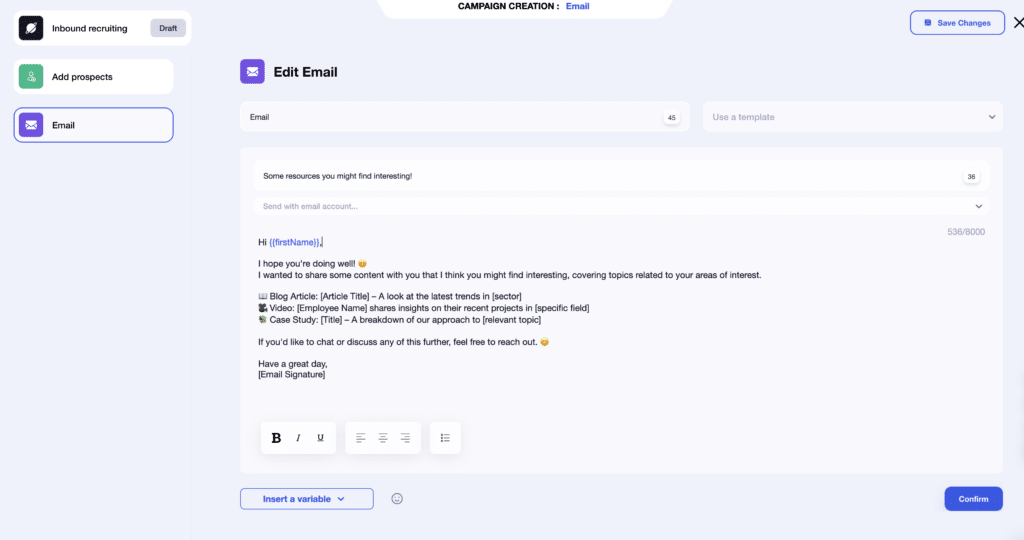
If you don’t have your leads’ e-mails yet, you can use our Email Finder, which will take care of it for you! 🕵🏻♀️
2. LinkedIn nurturing: Engage your candidates on LinkedIn.
Candidates are becoming more active on LinkedIn, making it the perfect platform to build a more “personal relationship.” With Waalaxy, you can:
- Automate LinkedIn messages after candidates engage with your posts. 💌
- Send personalized invitations to events, webinars, or share relevant content. 📚
To do this, nothing could be simpler: you can directly choose the Waalaxy sequence “Share a content (article or video)”. This sequence allows you to share really relevant resources with a targeted audience. 🎯 The aim here isn’t to recruit directly, but rather to offer value that interests and engages the talent you’re targeting. The message is already pre-populated, but it’s up to you to personalize it! 👩🏻🎨
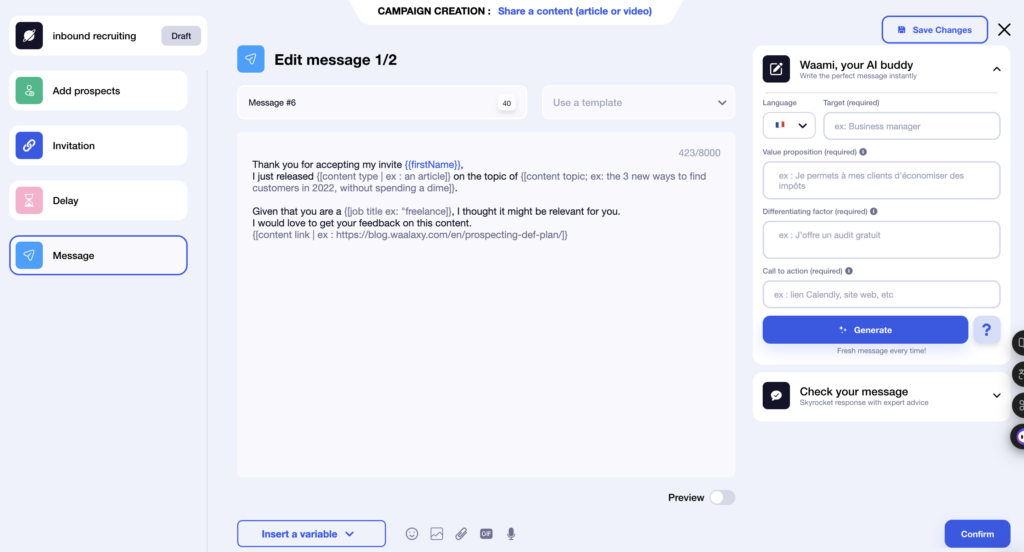
If you’re short of inspiration, consider using Waami, your AI writing assistant. 👀
3. Tag candidates: prioritize candidates according to their commitment.
Thanks to Waalaxy’s tagging features, you can categorize your leads based on their level of engagement or specific traits. For example:
- Less engaged leads can be added to long-term nurturing campaigns. ⏰
- A lead who opens multiple emails or interacts with several of your LinkedIn messages can be tagged as a “priority.” ✨
You can integrate tracked links into your campaigns to get further information on actions. 🔗
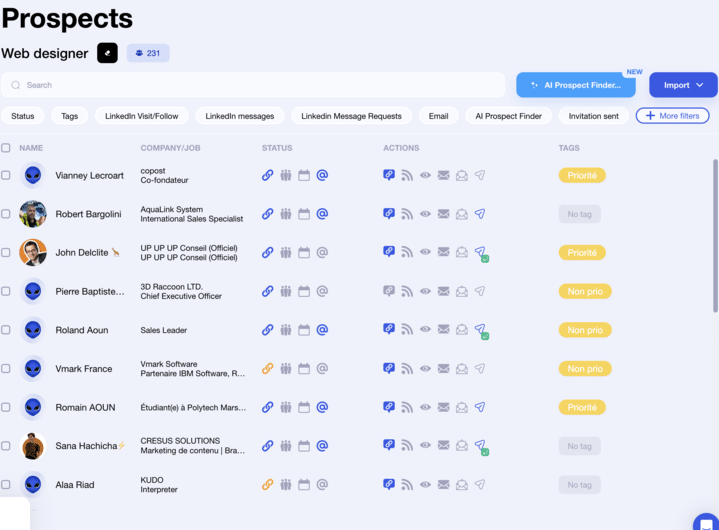
Step 4: Build loyalty 🤝
The recruitment process doesn’t end once a candidate is hired. Building loyalty is key to turning them into ambassadors for your company. Happy employees are the best recruiters! 🙌🏻
➡️ How? Here are a few tips:
- Internal newsletter: Create a newsletter to keep your employees updated on internal initiatives, new projects, and growth opportunities. This fosters a sense of belonging and keeps employees aligned with the company’s vision. 👀
- Internal events: Organize regular events (team buildings, conferences, workshops) to help your teams feel engaged in the company’s life. These events strengthen corporate culture and encourage commitment. 🎳
- Employee advocacy: Encourage employees to share their experiences on platforms like LinkedIn and promote the company. Set up “advocacy programs” where employees share content about the company and act as brand ambassadors in exchange for rewards. 📱
Example: A company launches an ambassador program where employees who share company-related content on LinkedIn receive a bonus based on the performance of their posts. The result? A significant increase in the number of professionals showing interest in the company, driven by these authentic recommendations. 💬
Here’s a diagram summarizing all the info 😎 :
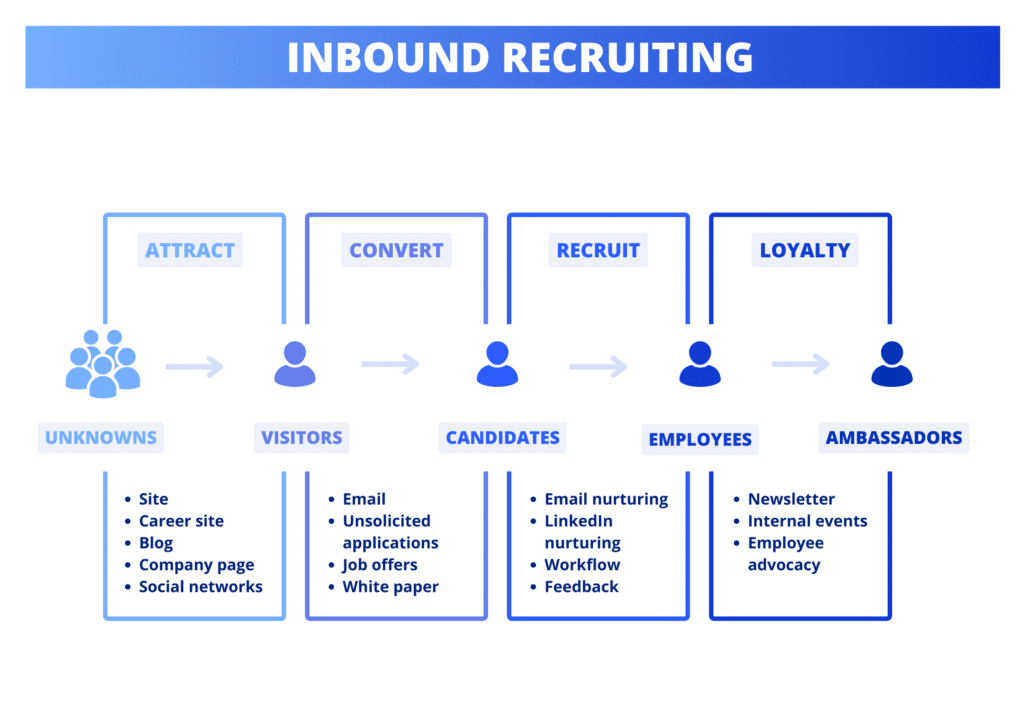
How about a recap?
Inbound recruiting follows a 4-stage strategy:
- Attract: Create relevant content (website, articles, social media) to draw in visitors. 📱
- Convert: Use emails, open applications, and online events to turn visitors into leads. 🙌🏻
- Recruit: Leverage tools like Waalaxy to automate the conversion of leads into active candidates. 👀
- Loyalty: Turn your employees into ambassadors through internal initiatives and employee advocacy. ❤️🔥
This approach aligns with the new expectations of candidates, who now seek more than just a job—they want to join a company that reflects their ideals and vision of the world. That’s why building a strong employer brand is more important than ever. ✨
Frequently asked questions
Inbound recruiting vs Outbound recruiting
Inbound recruiting focuses on attracting candidates by creating content and enhancing the employer brand. In contrast, outbound recruiting takes a more proactive approach, where the company actively seeks out talent. 🔍
➡️ Here’s the comparison chart:
| Criteria | Inbound Recruiting | Outbound Recruiting |
|---|---|---|
| Objective | Attract qualified talent by promoting the employer brand. | Actively seek out candidates. |
| Method | Creation of publications (blogs, videos, social networks). | Send direct messages (LinkedIn, emails). |
| Tools | SEO, Waalaxy for nurturing and list management, career site. | LinkedIn Recruiter, job boards, headhunting. |
| Cost | Low after implementation (long term). | High costs (paid ads, headhunters). |
| Duration of results | Long term, needs time to bear fruit. | Immediate but short-term results. |
| Use cases | Ongoing recruitment, creation of a pool of candidates. | Need to recruit quickly or for specific positions. |
| Examples of use | Attracting professionals in innovative or tech sectors. | Urgent need to recruit a senior profile for a key position. |
When to choose inbound or outbound recruiting?
- Opt for inbound recruiting if you want to build long-term relationships with talent. It’s perfect for creating an ongoing talent pool, strengthening your employer brand, and attracting candidates who share your values. 🤩
Example: A company in a growth sector like tech or digital marketing sets up an inbound recruiting strategy to regularly attract qualified candidates without constantly posting job ads. 📣
- Opt for outbound recruiting when you need to hire quickly for urgent or specialized roles. This approach is great for finding specific candidates, often for managerial roles or hard-to-find profiles. 💎
Example: You need to hire a CTO within two months. You launch an outbound recruiting campaign, reaching out directly to potential candidates on LinkedIn and using specialized job boards to get as many applications as possible in a short time. ⌛️
Now inbound recruiting holds no secrets for you! 🚀









